
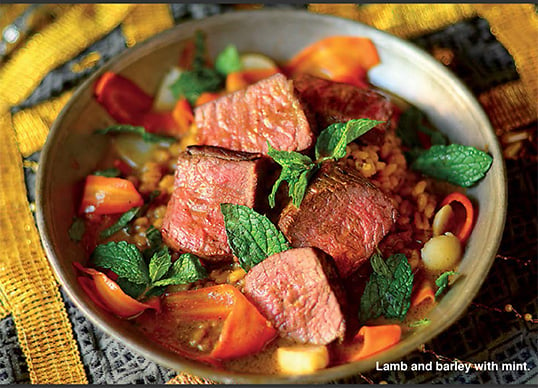 |
| DEANA SIDNEY |
| Written by Laura Kelley |
Take a journey back in time more than 2700 years to a royal banquet in the palace at Nineveh, capital of the Assyrian Empire. As you arrive, the scent of lilies and roses fills the air. Musicians play harps and pipes, sing songs and recite poems. You snack on fresh pistachios and walnuts as you wait for the entrance of the king. The woman next to you stirs, and her red linen tunic crinkles slightly against her fine cotton shawl. Her gold earrings softly jingle as she moves.
With her, you discuss your admiration for King Ashurbanipal, a learned man and, as you see him, a benevolent ruler. He is a generous patron of artists, astronomers and mathematicians in his court. On military and diplomatic missions, he has directed that his envoys collect plants, seeds, animals or anything unusual from the foreign lands they pass through; when they return, their finds have been placed in palace gardens, zoos and rooms filled with curiosities.
He has rebuilt and restored temples and buildings weakened by war or the simple ravages of time. But his greatest achievement by far is the systematic gathering and cataloging of knowledge. The library is a royal archive, but it also contains treatises on medicine, science and divination, collections of folktales—and even some favorite recipes.
Today, a few cuneiform tablets are the principal source of Mesopotamian recipes: the Yale Babylonian recipe tablets, which predate Ashurbanipal’s imaginary banquet by a little more than 1000 years. Tablet YBC 4644 has 25 recipes and two others, YBC 8958 and YBC 4648, contain 10 more. In addition to these sources, scholars generally acknowledge that there are two earlier
recipes, one from Mari, Syria for a confection known as mersu, and the other probably from Uruk, also in Syria, for what has been interpreted as “court bouillon.”
These ancient recipes are a fascinating challenge for modern cooks—not only because they are a window into the food culture of ancient Mesopotamia, but also because they are actually little more than lists of ingredients, usually with scant information on the amounts of ingredients to use, their form, or even how to prepare the dishes. Although difficult for some to navigate, the recipes allow for a great deal of creativity in using what is on hand or in reinterpreting dishes with favorite local and personal flavors. (In medieval Europe, recipes were typically written like this, and outside the industrialized world they still are.)
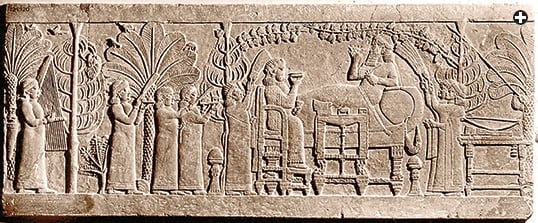 |
| Top: Yale BAbylonian Collection; Lower, Werner Forman / Art Resource |
| The 25 recipes inscribed in cuneiform on both sides of the tablet known as YBC 4644, top, were already 1000 years old when this bas-relief, lower, was carved to depict a banquet in the palace of Assyrian king Ashurbanipal. |
The Yale recipes were first translated by French historian Jean Bottéro and published in 1995 in Textes Culinaires Mésopotamiens. (Another book by Bottéro, The Oldest Cuisine in the World, was published in French in 2002, in English in 2004 and as a paperback in 2011.) In Bottéro’s view, the dishes that can be discerned from the tablets are rich in meat and onions—particularly onions, which he calls the characteristic ingredient of the cuisine. He translated the recipes of YBC 4644 into 25 broths or porridges: 21 were meat- or fowl-based, and four were vegetable-based. All featured onions, garlic and leeks.
When I first read Textes Culinaires Mésopotamiens, I remember being disappointed that one of the greatest kingdoms on earth apparently had such dull food. Why, I wondered, when they had contact with civilizations all around western Asia, the Levant and North Africa, possibly even southern Asia, would they eat so many onions? Bottéro himself pronounced the food fit only for his worst enemies. My curiosity was piqued, and I started digging for answers.
Well-known sources, such as the Sumerian and Akkadian lexicon found on the Urra=Hubullu tablets, as well as Assyrian bas-relief wall panels, show a rich culinary culture. Fruits named or shown range from pomegranates and dates to apricots, apples and pears; vegetables include radishes, beets and lettuce. Sheep and goats were both milked and eaten for meat, while other meat came from cattle, bison and oxen as well as from wild game. Wild and domesticated fowl, fish and shellfish of many varieties were enjoyed, as were milk products ranging from butter and cheese to yogurt and sour cream. These sources depict bountiful harvests at home; vibrant foreign trade and the flow of people in and out of the empire brought additional ingredients and culinary knowledge.
 |
| Miles collins |
| YBC 4644, recipe 20, can be successfully interpreted as a stew made with lamb, licorice, vegetables and juniper. |
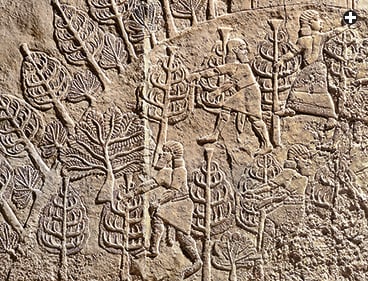 |
| de AgosTini picTure librAry / g dAgli orTi / bridgeMAn ArT librAry (deTAil) |
| This bas-relief of a harvest scene hints at the energy and deliberate care associated with food harvesting. |
Although a pioneer in the interpretation of Mesopotamian cuisine, Bottéro did not claim certainty in many of his culinary translations, and some ingredients he left untranslated altogether. This makes reconstruction of actual recipes extraordinarily challenging.
For example, one of the untranslated ingredients used in almost every recipe is samidu. Bottéro assumed that it was in the allium family, which includes onions, garlic, chives and leeks. Looking to modern languages, however, I found that in Hebrew and Syrian, semida means “fine meal” and, in Greek, semidalis is used to denote “the finest flour.” According to the University of Chicago’s Assyrian Dictionary, semidu is also defined as semolina. One ingredient identified; many more to go.
 |
| Laura Kelley |
| Lamb with carob is Recipe 19 on the YBC 4644 tablet. |
 |
| Catarina Grosso |
| Meat with licorice and citron is a recipe from Uruk, Syria, that dates to 400 bce. |
Similarly, several of the recipes feature an ingredient called kasû, which was interpreted as dodder, a parasitic weed of the genus Cuscuta. Puzzled by the use of a bitter weed in these dishes, I found an alternate meaning in a paper by Near Eastern scholar Piotr Steinkeller, who argued that kasû was probably wild licorice (Glycyrrhiza glabra), and that it was used by the Mesopotamians both in cooking and in making beer.
Also, mersu was interpreted as a cake because of the similarity between that word and marâsu, which means “to mix,” and because mersu was described as comprised of nuts and dates. Yet there is nothing to imply that mersu was a cake, let alone any instructions on how to make it.
Could mersu be something else? A look at modern western Asian and Levantine cuisines hints that mersu could easily have been a date-nut roll, or a beautiful date “candy,” as well. Both sweets are based on pounded dates and chopped nuts or other fruit or nut toppings.
Or, adding only some type of flour, mersu could resemble the modern Iranian dessert ranginak, which consists of dates stuffed with pistachios enclosed in a thin crust of dough. Or it could be like the modern Lebanese ma‘moul, which has a pounded-date center covered in a layer of semolina that is then covered in a layer of chopped pistachios. Looking to non-European cuisines shows us the many possible, culturally plausible variations for mersu other than “cake.”
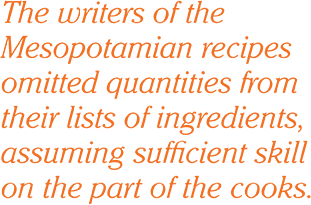 |
My current research, and kitchen experimentation by myself and others, is providing some revised interpretations of the Yale tablet recipes. In fact, I don’t think that any of the recipes on YBC 4644 represent either broths or porridges; rather, they are general guidelines for the flavors of dishes that range from stew-like koreshes, curries and soups to braised meats and dry pilafs. It all depends on the relative proportions of liquid and solid ingredients. As noted earlier, amounts of ingredients are almost always absent from these recipes, so the exact dish prepared is left up to the cook—who is assumed to have sufficient training to understand and use the recipes in this form.
For example, Recipe 19 on YBC 4644 is for halazzu, which is untranslated. I believe it to be a recipe for lamb or beef with carob: Halazzu was proposed as carob by several previous Assyriologists, and substituting “carob” for it in the recipe makes for a delicious stew or sauce. Recipe 20, called “salted broth,” I interpret as mutton with wild licorice and juniper; Recipe 23, for kanasu—another term left untranslated—I think is lamb with grain and mint. Lastly, I have found a delicious grain and herb pilaf in Recipe 25 by using the alternative definition of laptu, which Bottéro translated as “turnip” without mentioning that “barley” is an equally accepted translation among scholars.
 |
| Erich Lessing / Art Resource |
| A flute player from a stone bas-relief at the palace in Nineveh. |
In addition to new interpretations for recipes, I also found a rich source for other recipes in translations of texts about foods prepared as offerings for gods. According to Vanderbilt University scholar Jack M. Sasson, the intimate connection between the Mesopotamians and their deities makes it reasonable to assume a connection between foods offered to the gods and those enjoyed on home tables—or at least those served to the elite, for the elite also ate from the divine table, thus providing an added incentive to delight the palate. For instance, Marcel Sigrist’s translations of offerings at the Mesopotamian city of Nippur give several more ingredients for mersu, such as figs, raisins, minced apples, minced garlic, oil or butter, soft or hard cheese, and wine must or syrup. This widens the field of variation for the dish and allows cooks to mix and match combinations of ingredients. Also from the same paper is a recipe for a bread called ninda-gal that lists sumac, saffron and onion seeds as ingredients. In addition to being new sources for recipes, these offerings may also provide insight into some of the foods eaten by Mesopotamian people.
Assisted by a small group of chefs and cooks from three continents, I recently explored these and other Mesopotamian recipes. I cooked a lamb and carob stew, lamb chops with carob sauce, hen with herbs (from YBC 8958), barley and herb pilaf and several mersu variations. Others cooked lamb with grain and mint (substituting barley for couscous or wheatberries, the most likely forms of emmer grain used in the recipe), several variations of lamb with licorice and juniper, and pork tenderloin with licorice and citron.
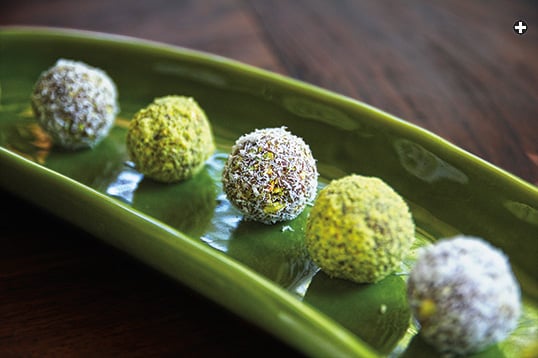 |
| Sasha Martin / globaltableadventure.com |
| Mersu, first interpreted as “cake,” seems more likely to have been a type of date-and-nut ball. |
So how did these reinterpreted dishes taste? In a word—delicious. The flavors are unusual and complex, but enjoyable, tasting as if they could have been created by a skilled modern chef. Far from being suited to an enemy, these dishes are best shared with a dear friend.
In addition to experiencing new flavors in these Mesopotamian dishes, cooking some of the oldest recipes in the world transports you far, far back in time and opens a window on a wider world. From it, you might glimpse Babylon, Nippur or the palace banquet at Nineveh.

 Hen with Herbs (Yale Babylonian Collection 8958, Recipe 2) Hen with Herbs (Yale Babylonian Collection 8958, Recipe 2)
|
Ingredients from the tablet: pigeon, salt, water, fat, vinegar, semolina, leek, garlic, shallots, tulip bulb, yogurt or sour cream, and “greens.” As with all Mesopotamian recipes, how these are put together, and in what quantities, is up to you. For this, I substitute Cornish game hen for pigeon. |
|
2 Cornish game hens, cleaned and salted
inside and out
4 c. water
2 c. chicken stock
1 c. pomegranate vinegar
3 Tbs. butter
¼ tsp. asafetida
2 tsps. dried mint
2 Tbs. coriander seed
1 tsps. cumin seeds
1 large Sri Lankan cinnamon stick
1 handful baby arugula, chopped
|
½ yellow onion
1 leek, white and green parts, well cleaned
10-11 garlic cloves, peeled
½ c. lightly drained yogurt
3 handfuls of fresh mint leaves
1 handful of fresh sage
Water to moisten herbs
More pomegranate vinegar to rinse hens
1-3 tsps. semolina to thicken sauce
|
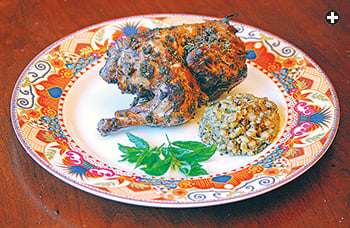 |
| Laura Kelley |
Clean and dry fowl and salt liberally, inside and out. Set aside. Prepare water, stock and vinegar in a large stockpot or kettle large enough to hold the hens. Add butter, asafetida, mint and arugula, and heat over a high flame, stirring occasionally. When the water has come to a boil, add the hens and return to a boil. Reduce heat a bit and cook uncovered over medium heat for 5 minutes. Then reduce heat till liquid just bubbles. Cover and cook for 5 minutes.
In a food processor, pulse together the onion, leek, 6 to 7 cloves of garlic and lightly drained yogurt until it is a small dice or mince. Add it to the water and chickens, and continue to cook for another 5 to 10 minutes; do not overcook. Total cooking time for hens in the pot is 15 to 20 minutes. When done, remove birds from the pot and set aside until cool enough to handle.
Preheat broiler to high. While cooling the hens, take the stock you used to cook the hens and pour it into a clean saucepan. If you are using a cup or two of stock to make couscous, barley or some other grain, do so now and pour off about one-third to one-half of the stock that remains. Heat to a steady low boil, stirring constantly, and cook uncovered to reduce, stirring occasionally.
Pulse the mint and sage (or other herbs you choose) with the remaining garlic in the food processor a few times until nicely minced and add a teaspoon or so of water to moisten them. Divide hens in two, down the spine, by slicing with a large, sharp knife or cleaver. Pour pomegranate vinegar over the hens, inside and out, to wash away herbs from cooking and set aside.
Rub both sides of the hens with the mint and sage herb mixture until an even coating is achieved and set aside. Continue to cook stock until it starts to thicken. Add semolina to facilitate this process; stir until dissolved.
Place hens rib side down on a lightly sprayed baking sheet. Cook under the preheated broiler flame 4 to 5 minutes per side. Watch constantly and be careful not to burn the hens.
Turn baking sheet as necessary to ensure even cooking. When done, remove from heat and let rest 5 to 10 minutes while finishing the sauce.
If desired, strain the sauce. (I did not, preferring a more rustic presentation.) I served the dish in a shallow bowl, adding a layer of roasted barley and herb pilaf and sauce beneath the hen and a bit of sauce on the fowl. |

|
 Roasted Barley and Herb Pilaf (Yale Babylonian Collection 4644, Recipe 25) Roasted Barley and Herb Pilaf (Yale Babylonian Collection 4644, Recipe 25)
|
Ingredients from the tablet: water, fat, roasted barley, mix of chopped shallots, arugula, and coriander, semolina, blood, mashed leeks and garlic. |
|
1 c. whole barley, cleaned 2 c. water
1 c. prepared stock
2 tsps. of butter
1 tsp. salt
¼ tsp. asafetida
1 tsp. ground coriander
|
3 shallots, peeled
1 handful of baby arugula
2 tsps. semolina
2 tsps. blood (optional, if available)
1 leek, white and green parts, well cleaned
4-5 garlic cloves, peeled
|
Preheat broiler to the highest setting. Spread the cleaned barley on a baking sheet to form a single layer of grain. Place barley under broiler flame and leave for a few minutes until it starts to smoke and color. Stir lightly and turn pan if necessary until most barley is tan in color. Be careful not to burn the grain. Properly roasted barley will taste nutty. When done, remove from flame and let cool.
Add water and prepared stock to a medium saucepan. You may season the stock any way you wish, or use the cooking stock from another recipe. (I used the stock from the hen recipe above.) Add butter, salt, asafetida and ground coriander, and continue to heat.
In a food processor, pulse shallots and arugula once or twice. Then add the semolina and blood, and pulse one or two more times. Add this mixture to the heating, water and stir. When just short of a boil, add the barley and stir well. Bring back to a boil. Then reduce heat, cover and cook over a medium-low flame until about three-quarters done—20 to 30 minutes.
As the barley is cooking, pulse leeks and garlic two to four times until minced but not mushy. Add this to the barley and stir once or twice—not too much or barley will be soggy. Partially re-cover saucepan and continue to cook, checking frequently. It should be done or nearly done within 10 minutes. |